Annotated Bibliography: Exploring Business Communication in MGT502
VerifiedAdded on 2022/10/06
|12
|2578
|14
Annotated Bibliography
AI Summary
This annotated bibliography, prepared for a business communication course (MGT502), presents a collection of scholarly articles exploring various facets of business communication. The bibliography covers a range of topics, including the impact of corporate social responsibility (CSR) on communication, the effectiveness of social media in business, the role of internal communication in employee engagement, the influence of leadership styles on organizational reputation, and the importance of intercultural communication. Each entry provides a concise summary of the article's key arguments, methodologies, and findings, along with contrasting viewpoints from other researchers. The bibliography aims to provide a comprehensive overview of current research in business communication, offering valuable insights for understanding effective communication strategies within organizations. The included articles discuss the effects of greenwashing, the impact of consumer reviews, and the importance of employee-centered communication. This assignment highlights the intricate relationship between communication and various business functions, such as marketing, human resources, and leadership.
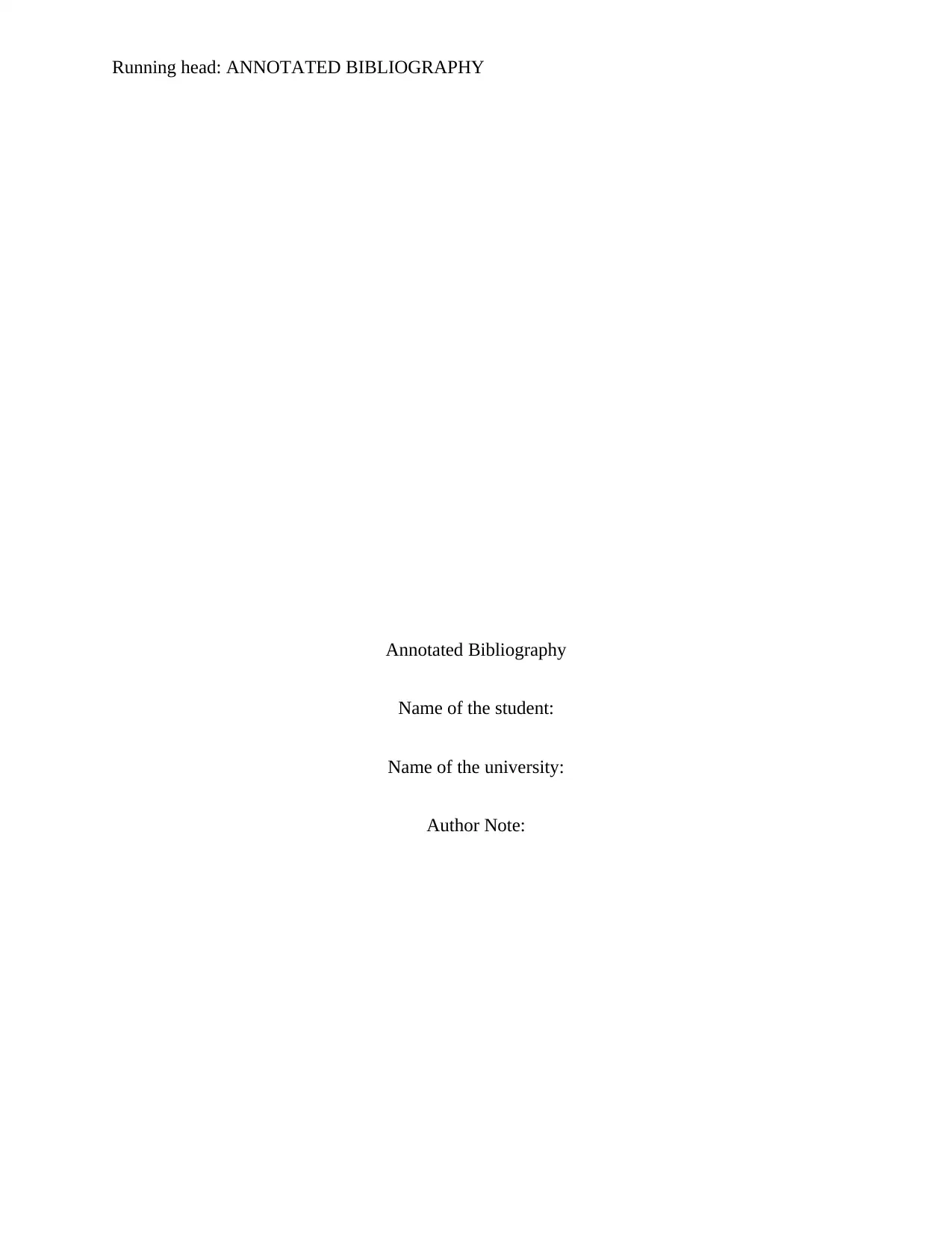
Running head: ANNOTATED BIBLIOGRAPHY
Annotated Bibliography
Name of the student:
Name of the university:
Author Note:
Annotated Bibliography
Name of the student:
Name of the university:
Author Note:
Paraphrase This Document
Need a fresh take? Get an instant paraphrase of this document with our AI Paraphraser
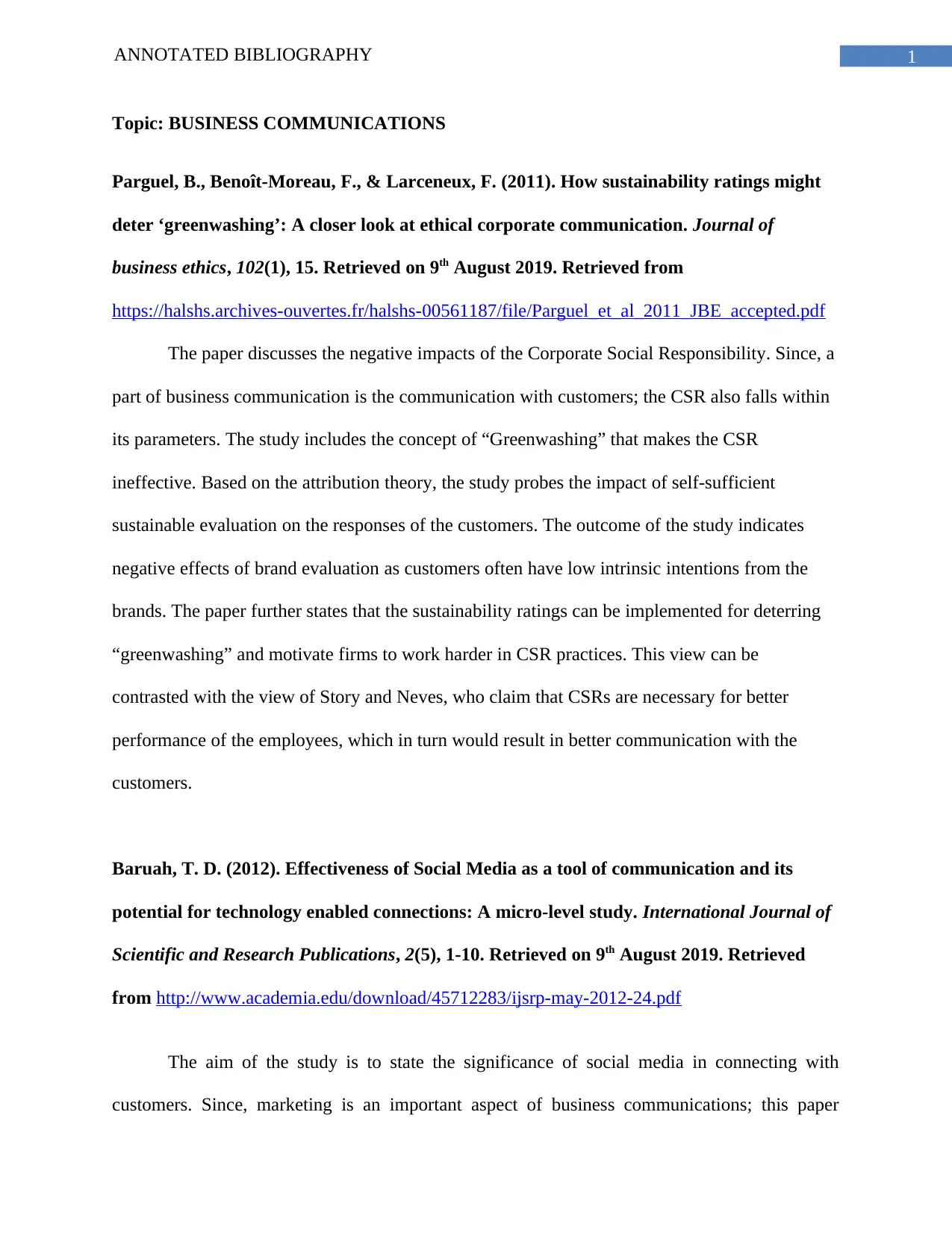
1ANNOTATED BIBLIOGRAPHY
Topic: BUSINESS COMMUNICATIONS
Parguel, B., Benoît-Moreau, F., & Larceneux, F. (2011). How sustainability ratings might
deter ‘greenwashing’: A closer look at ethical corporate communication. Journal of
business ethics, 102(1), 15. Retrieved on 9th August 2019. Retrieved from
https://halshs.archives-ouvertes.fr/halshs-00561187/file/Parguel_et_al_2011_JBE_accepted.pdf
The paper discusses the negative impacts of the Corporate Social Responsibility. Since, a
part of business communication is the communication with customers; the CSR also falls within
its parameters. The study includes the concept of “Greenwashing” that makes the CSR
ineffective. Based on the attribution theory, the study probes the impact of self-sufficient
sustainable evaluation on the responses of the customers. The outcome of the study indicates
negative effects of brand evaluation as customers often have low intrinsic intentions from the
brands. The paper further states that the sustainability ratings can be implemented for deterring
“greenwashing” and motivate firms to work harder in CSR practices. This view can be
contrasted with the view of Story and Neves, who claim that CSRs are necessary for better
performance of the employees, which in turn would result in better communication with the
customers.
Baruah, T. D. (2012). Effectiveness of Social Media as a tool of communication and its
potential for technology enabled connections: A micro-level study. International Journal of
Scientific and Research Publications, 2(5), 1-10. Retrieved on 9th August 2019. Retrieved
from http://www.academia.edu/download/45712283/ijsrp-may-2012-24.pdf
The aim of the study is to state the significance of social media in connecting with
customers. Since, marketing is an important aspect of business communications; this paper
Topic: BUSINESS COMMUNICATIONS
Parguel, B., Benoît-Moreau, F., & Larceneux, F. (2011). How sustainability ratings might
deter ‘greenwashing’: A closer look at ethical corporate communication. Journal of
business ethics, 102(1), 15. Retrieved on 9th August 2019. Retrieved from
https://halshs.archives-ouvertes.fr/halshs-00561187/file/Parguel_et_al_2011_JBE_accepted.pdf
The paper discusses the negative impacts of the Corporate Social Responsibility. Since, a
part of business communication is the communication with customers; the CSR also falls within
its parameters. The study includes the concept of “Greenwashing” that makes the CSR
ineffective. Based on the attribution theory, the study probes the impact of self-sufficient
sustainable evaluation on the responses of the customers. The outcome of the study indicates
negative effects of brand evaluation as customers often have low intrinsic intentions from the
brands. The paper further states that the sustainability ratings can be implemented for deterring
“greenwashing” and motivate firms to work harder in CSR practices. This view can be
contrasted with the view of Story and Neves, who claim that CSRs are necessary for better
performance of the employees, which in turn would result in better communication with the
customers.
Baruah, T. D. (2012). Effectiveness of Social Media as a tool of communication and its
potential for technology enabled connections: A micro-level study. International Journal of
Scientific and Research Publications, 2(5), 1-10. Retrieved on 9th August 2019. Retrieved
from http://www.academia.edu/download/45712283/ijsrp-may-2012-24.pdf
The aim of the study is to state the significance of social media in connecting with
customers. Since, marketing is an important aspect of business communications; this paper
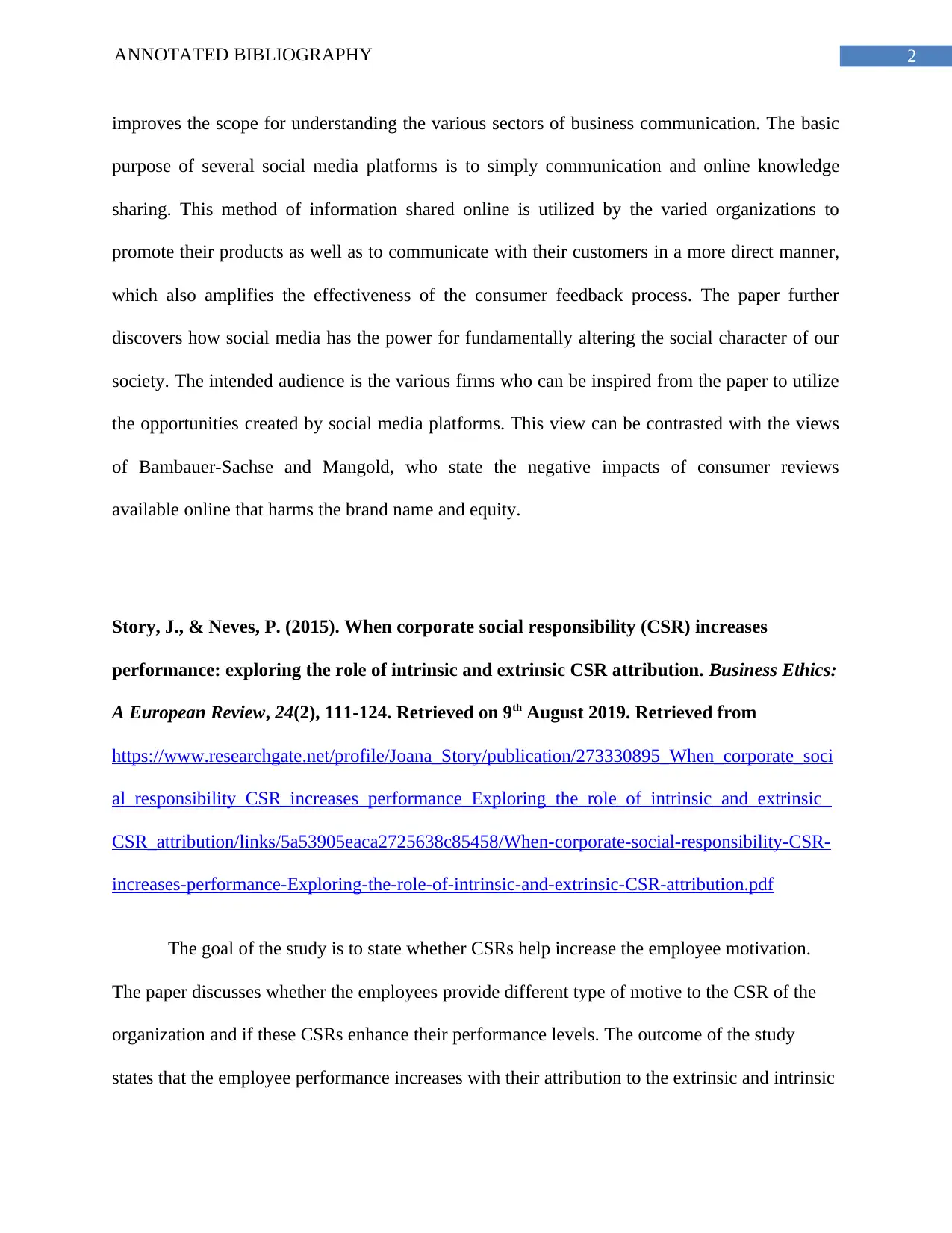
2ANNOTATED BIBLIOGRAPHY
improves the scope for understanding the various sectors of business communication. The basic
purpose of several social media platforms is to simply communication and online knowledge
sharing. This method of information shared online is utilized by the varied organizations to
promote their products as well as to communicate with their customers in a more direct manner,
which also amplifies the effectiveness of the consumer feedback process. The paper further
discovers how social media has the power for fundamentally altering the social character of our
society. The intended audience is the various firms who can be inspired from the paper to utilize
the opportunities created by social media platforms. This view can be contrasted with the views
of Bambauer-Sachse and Mangold, who state the negative impacts of consumer reviews
available online that harms the brand name and equity.
Story, J., & Neves, P. (2015). When corporate social responsibility (CSR) increases
performance: exploring the role of intrinsic and extrinsic CSR attribution. Business Ethics:
A European Review, 24(2), 111-124. Retrieved on 9th August 2019. Retrieved from
https://www.researchgate.net/profile/Joana_Story/publication/273330895_When_corporate_soci
al_responsibility_CSR_increases_performance_Exploring_the_role_of_intrinsic_and_extrinsic_
CSR_attribution/links/5a53905eaca2725638c85458/When-corporate-social-responsibility-CSR-
increases-performance-Exploring-the-role-of-intrinsic-and-extrinsic-CSR-attribution.pdf
The goal of the study is to state whether CSRs help increase the employee motivation.
The paper discusses whether the employees provide different type of motive to the CSR of the
organization and if these CSRs enhance their performance levels. The outcome of the study
states that the employee performance increases with their attribution to the extrinsic and intrinsic
improves the scope for understanding the various sectors of business communication. The basic
purpose of several social media platforms is to simply communication and online knowledge
sharing. This method of information shared online is utilized by the varied organizations to
promote their products as well as to communicate with their customers in a more direct manner,
which also amplifies the effectiveness of the consumer feedback process. The paper further
discovers how social media has the power for fundamentally altering the social character of our
society. The intended audience is the various firms who can be inspired from the paper to utilize
the opportunities created by social media platforms. This view can be contrasted with the views
of Bambauer-Sachse and Mangold, who state the negative impacts of consumer reviews
available online that harms the brand name and equity.
Story, J., & Neves, P. (2015). When corporate social responsibility (CSR) increases
performance: exploring the role of intrinsic and extrinsic CSR attribution. Business Ethics:
A European Review, 24(2), 111-124. Retrieved on 9th August 2019. Retrieved from
https://www.researchgate.net/profile/Joana_Story/publication/273330895_When_corporate_soci
al_responsibility_CSR_increases_performance_Exploring_the_role_of_intrinsic_and_extrinsic_
CSR_attribution/links/5a53905eaca2725638c85458/When-corporate-social-responsibility-CSR-
increases-performance-Exploring-the-role-of-intrinsic-and-extrinsic-CSR-attribution.pdf
The goal of the study is to state whether CSRs help increase the employee motivation.
The paper discusses whether the employees provide different type of motive to the CSR of the
organization and if these CSRs enhance their performance levels. The outcome of the study
states that the employee performance increases with their attribution to the extrinsic and intrinsic
⊘ This is a preview!⊘
Do you want full access?
Subscribe today to unlock all pages.

Trusted by 1+ million students worldwide
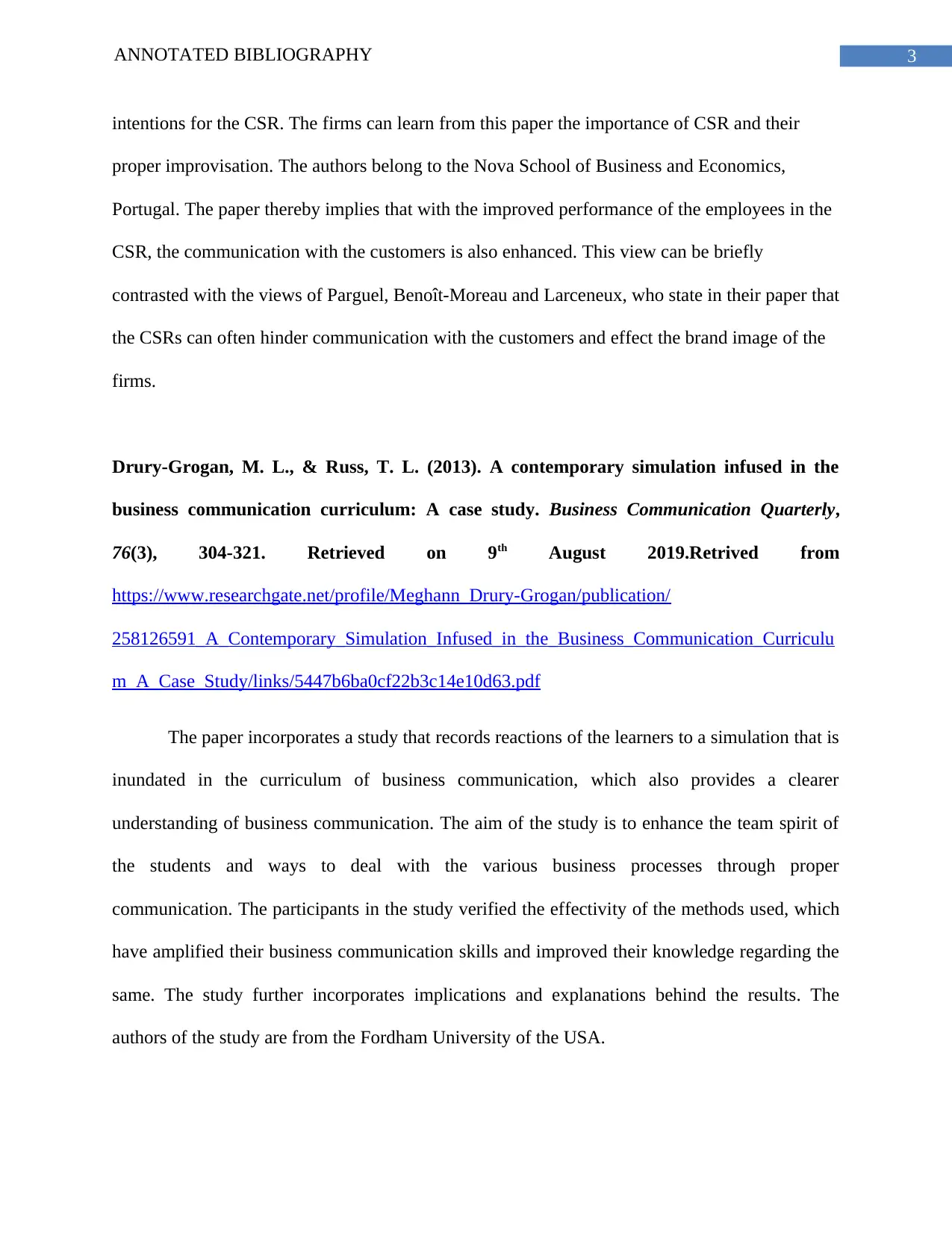
3ANNOTATED BIBLIOGRAPHY
intentions for the CSR. The firms can learn from this paper the importance of CSR and their
proper improvisation. The authors belong to the Nova School of Business and Economics,
Portugal. The paper thereby implies that with the improved performance of the employees in the
CSR, the communication with the customers is also enhanced. This view can be briefly
contrasted with the views of Parguel, Benoît-Moreau and Larceneux, who state in their paper that
the CSRs can often hinder communication with the customers and effect the brand image of the
firms.
Drury-Grogan, M. L., & Russ, T. L. (2013). A contemporary simulation infused in the
business communication curriculum: A case study. Business Communication Quarterly,
76(3), 304-321. Retrieved on 9th August 2019.Retrived from
https://www.researchgate.net/profile/Meghann_Drury-Grogan/publication/
258126591_A_Contemporary_Simulation_Infused_in_the_Business_Communication_Curriculu
m_A_Case_Study/links/5447b6ba0cf22b3c14e10d63.pdf
The paper incorporates a study that records reactions of the learners to a simulation that is
inundated in the curriculum of business communication, which also provides a clearer
understanding of business communication. The aim of the study is to enhance the team spirit of
the students and ways to deal with the various business processes through proper
communication. The participants in the study verified the effectivity of the methods used, which
have amplified their business communication skills and improved their knowledge regarding the
same. The study further incorporates implications and explanations behind the results. The
authors of the study are from the Fordham University of the USA.
intentions for the CSR. The firms can learn from this paper the importance of CSR and their
proper improvisation. The authors belong to the Nova School of Business and Economics,
Portugal. The paper thereby implies that with the improved performance of the employees in the
CSR, the communication with the customers is also enhanced. This view can be briefly
contrasted with the views of Parguel, Benoît-Moreau and Larceneux, who state in their paper that
the CSRs can often hinder communication with the customers and effect the brand image of the
firms.
Drury-Grogan, M. L., & Russ, T. L. (2013). A contemporary simulation infused in the
business communication curriculum: A case study. Business Communication Quarterly,
76(3), 304-321. Retrieved on 9th August 2019.Retrived from
https://www.researchgate.net/profile/Meghann_Drury-Grogan/publication/
258126591_A_Contemporary_Simulation_Infused_in_the_Business_Communication_Curriculu
m_A_Case_Study/links/5447b6ba0cf22b3c14e10d63.pdf
The paper incorporates a study that records reactions of the learners to a simulation that is
inundated in the curriculum of business communication, which also provides a clearer
understanding of business communication. The aim of the study is to enhance the team spirit of
the students and ways to deal with the various business processes through proper
communication. The participants in the study verified the effectivity of the methods used, which
have amplified their business communication skills and improved their knowledge regarding the
same. The study further incorporates implications and explanations behind the results. The
authors of the study are from the Fordham University of the USA.
Paraphrase This Document
Need a fresh take? Get an instant paraphrase of this document with our AI Paraphraser
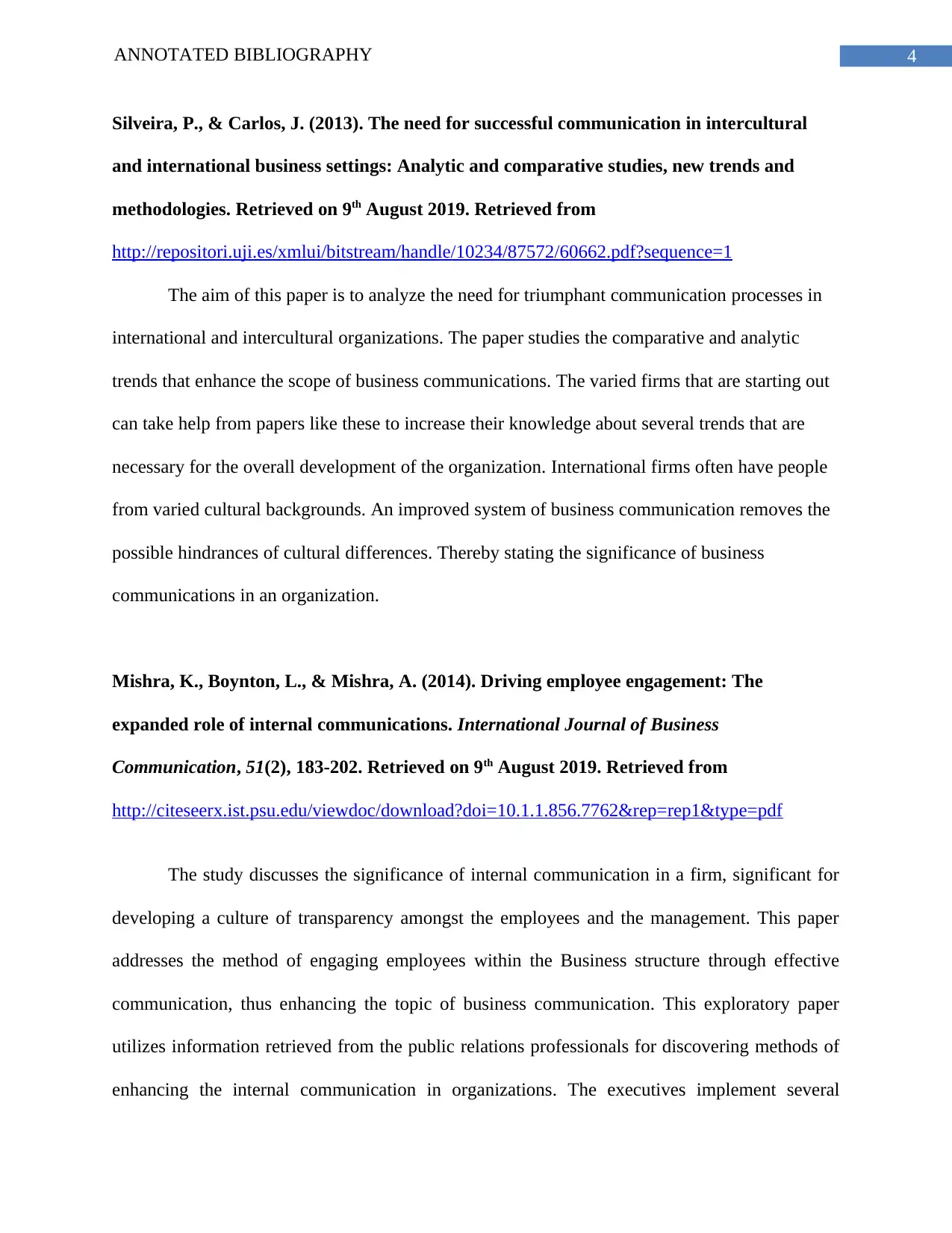
4ANNOTATED BIBLIOGRAPHY
Silveira, P., & Carlos, J. (2013). The need for successful communication in intercultural
and international business settings: Analytic and comparative studies, new trends and
methodologies. Retrieved on 9th August 2019. Retrieved from
http://repositori.uji.es/xmlui/bitstream/handle/10234/87572/60662.pdf?sequence=1
The aim of this paper is to analyze the need for triumphant communication processes in
international and intercultural organizations. The paper studies the comparative and analytic
trends that enhance the scope of business communications. The varied firms that are starting out
can take help from papers like these to increase their knowledge about several trends that are
necessary for the overall development of the organization. International firms often have people
from varied cultural backgrounds. An improved system of business communication removes the
possible hindrances of cultural differences. Thereby stating the significance of business
communications in an organization.
Mishra, K., Boynton, L., & Mishra, A. (2014). Driving employee engagement: The
expanded role of internal communications. International Journal of Business
Communication, 51(2), 183-202. Retrieved on 9th August 2019. Retrieved from
http://citeseerx.ist.psu.edu/viewdoc/download?doi=10.1.1.856.7762&rep=rep1&type=pdf
The study discusses the significance of internal communication in a firm, significant for
developing a culture of transparency amongst the employees and the management. This paper
addresses the method of engaging employees within the Business structure through effective
communication, thus enhancing the topic of business communication. This exploratory paper
utilizes information retrieved from the public relations professionals for discovering methods of
enhancing the internal communication in organizations. The executives implement several
Silveira, P., & Carlos, J. (2013). The need for successful communication in intercultural
and international business settings: Analytic and comparative studies, new trends and
methodologies. Retrieved on 9th August 2019. Retrieved from
http://repositori.uji.es/xmlui/bitstream/handle/10234/87572/60662.pdf?sequence=1
The aim of this paper is to analyze the need for triumphant communication processes in
international and intercultural organizations. The paper studies the comparative and analytic
trends that enhance the scope of business communications. The varied firms that are starting out
can take help from papers like these to increase their knowledge about several trends that are
necessary for the overall development of the organization. International firms often have people
from varied cultural backgrounds. An improved system of business communication removes the
possible hindrances of cultural differences. Thereby stating the significance of business
communications in an organization.
Mishra, K., Boynton, L., & Mishra, A. (2014). Driving employee engagement: The
expanded role of internal communications. International Journal of Business
Communication, 51(2), 183-202. Retrieved on 9th August 2019. Retrieved from
http://citeseerx.ist.psu.edu/viewdoc/download?doi=10.1.1.856.7762&rep=rep1&type=pdf
The study discusses the significance of internal communication in a firm, significant for
developing a culture of transparency amongst the employees and the management. This paper
addresses the method of engaging employees within the Business structure through effective
communication, thus enhancing the topic of business communication. This exploratory paper
utilizes information retrieved from the public relations professionals for discovering methods of
enhancing the internal communication in organizations. The executives implement several
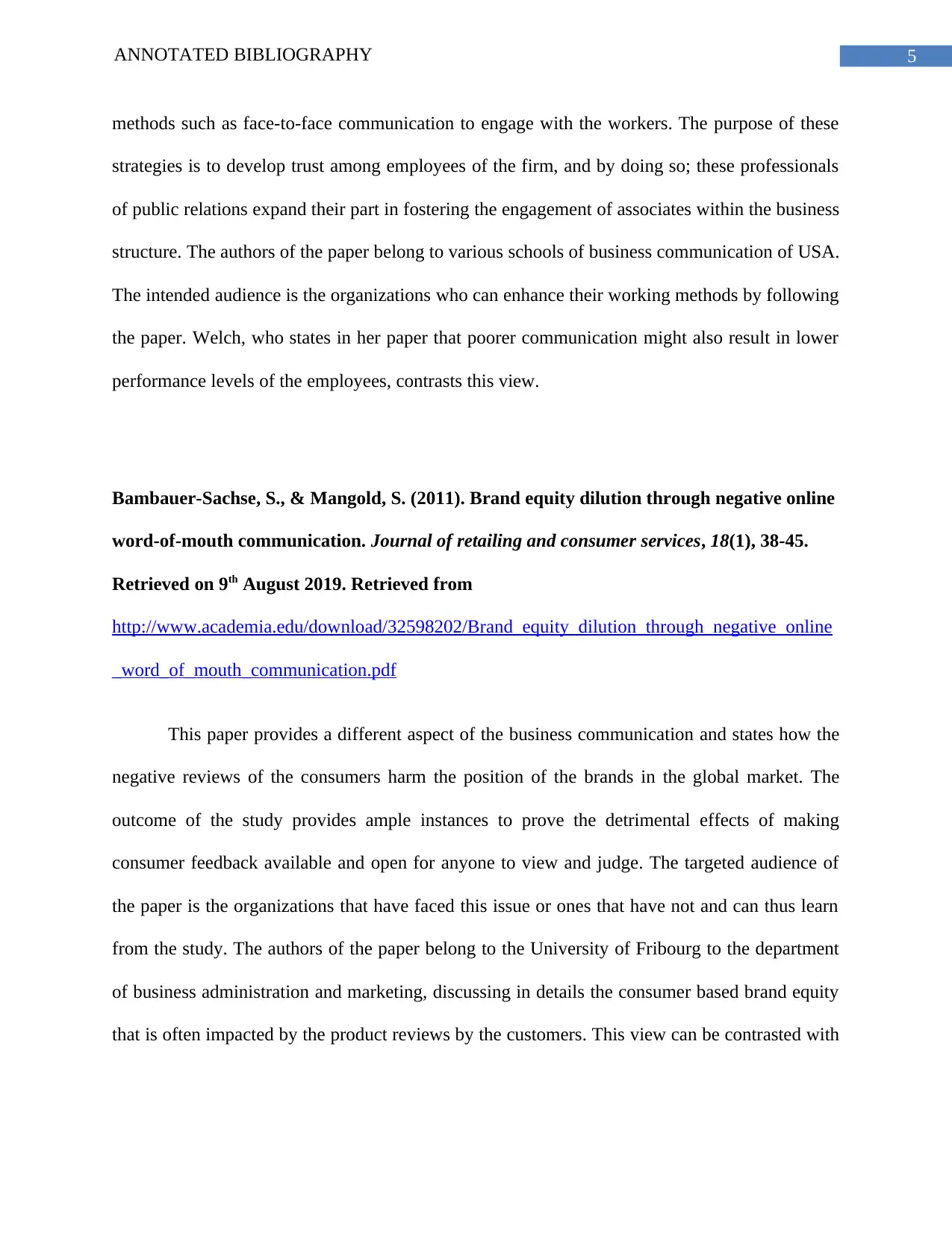
5ANNOTATED BIBLIOGRAPHY
methods such as face-to-face communication to engage with the workers. The purpose of these
strategies is to develop trust among employees of the firm, and by doing so; these professionals
of public relations expand their part in fostering the engagement of associates within the business
structure. The authors of the paper belong to various schools of business communication of USA.
The intended audience is the organizations who can enhance their working methods by following
the paper. Welch, who states in her paper that poorer communication might also result in lower
performance levels of the employees, contrasts this view.
Bambauer-Sachse, S., & Mangold, S. (2011). Brand equity dilution through negative online
word-of-mouth communication. Journal of retailing and consumer services, 18(1), 38-45.
Retrieved on 9th August 2019. Retrieved from
http://www.academia.edu/download/32598202/Brand_equity_dilution_through_negative_online
_word_of_mouth_communication.pdf
This paper provides a different aspect of the business communication and states how the
negative reviews of the consumers harm the position of the brands in the global market. The
outcome of the study provides ample instances to prove the detrimental effects of making
consumer feedback available and open for anyone to view and judge. The targeted audience of
the paper is the organizations that have faced this issue or ones that have not and can thus learn
from the study. The authors of the paper belong to the University of Fribourg to the department
of business administration and marketing, discussing in details the consumer based brand equity
that is often impacted by the product reviews by the customers. This view can be contrasted with
methods such as face-to-face communication to engage with the workers. The purpose of these
strategies is to develop trust among employees of the firm, and by doing so; these professionals
of public relations expand their part in fostering the engagement of associates within the business
structure. The authors of the paper belong to various schools of business communication of USA.
The intended audience is the organizations who can enhance their working methods by following
the paper. Welch, who states in her paper that poorer communication might also result in lower
performance levels of the employees, contrasts this view.
Bambauer-Sachse, S., & Mangold, S. (2011). Brand equity dilution through negative online
word-of-mouth communication. Journal of retailing and consumer services, 18(1), 38-45.
Retrieved on 9th August 2019. Retrieved from
http://www.academia.edu/download/32598202/Brand_equity_dilution_through_negative_online
_word_of_mouth_communication.pdf
This paper provides a different aspect of the business communication and states how the
negative reviews of the consumers harm the position of the brands in the global market. The
outcome of the study provides ample instances to prove the detrimental effects of making
consumer feedback available and open for anyone to view and judge. The targeted audience of
the paper is the organizations that have faced this issue or ones that have not and can thus learn
from the study. The authors of the paper belong to the University of Fribourg to the department
of business administration and marketing, discussing in details the consumer based brand equity
that is often impacted by the product reviews by the customers. This view can be contrasted with
⊘ This is a preview!⊘
Do you want full access?
Subscribe today to unlock all pages.

Trusted by 1+ million students worldwide
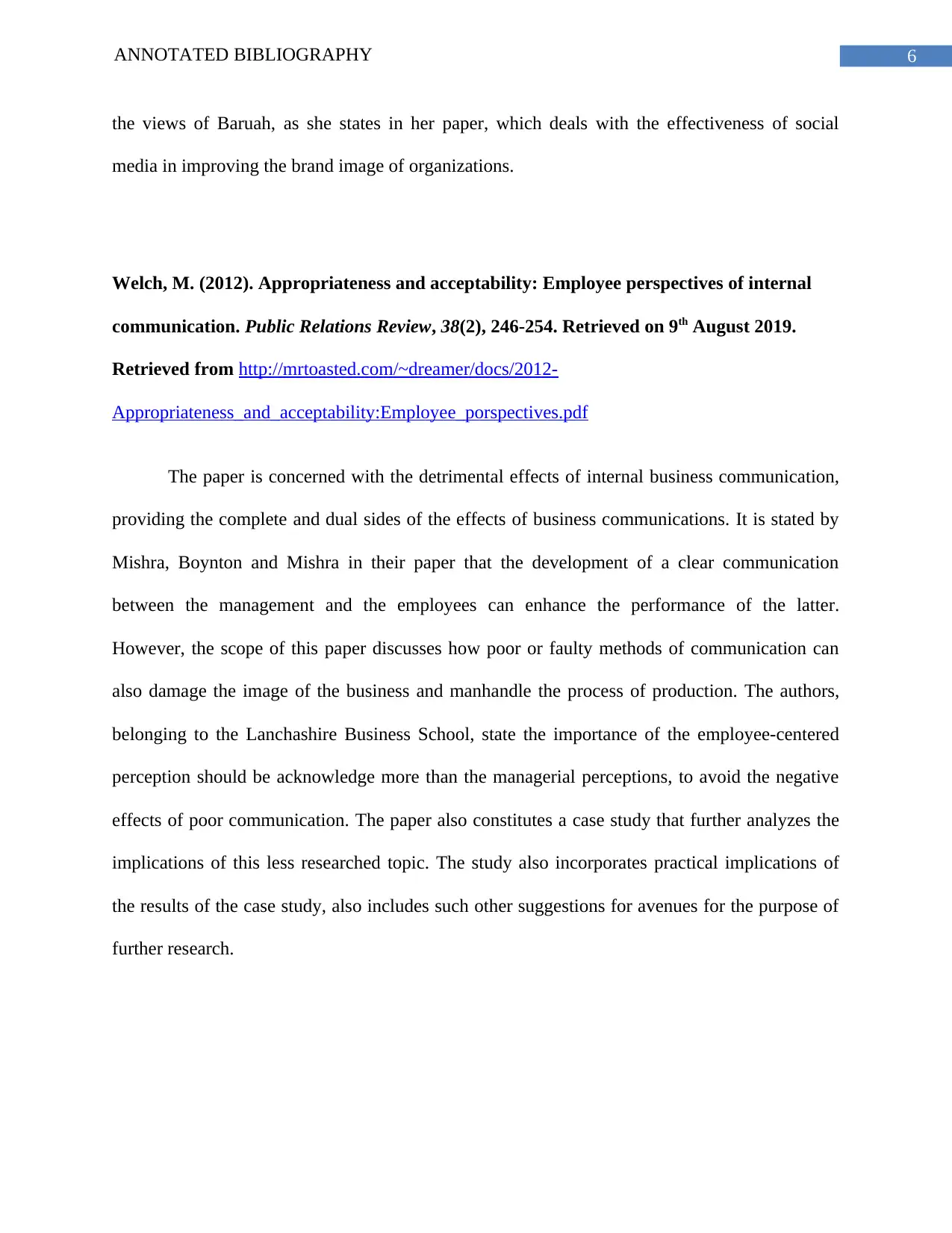
6ANNOTATED BIBLIOGRAPHY
the views of Baruah, as she states in her paper, which deals with the effectiveness of social
media in improving the brand image of organizations.
Welch, M. (2012). Appropriateness and acceptability: Employee perspectives of internal
communication. Public Relations Review, 38(2), 246-254. Retrieved on 9th August 2019.
Retrieved from http://mrtoasted.com/~dreamer/docs/2012-
Appropriateness_and_acceptability:Employee_porspectives.pdf
The paper is concerned with the detrimental effects of internal business communication,
providing the complete and dual sides of the effects of business communications. It is stated by
Mishra, Boynton and Mishra in their paper that the development of a clear communication
between the management and the employees can enhance the performance of the latter.
However, the scope of this paper discusses how poor or faulty methods of communication can
also damage the image of the business and manhandle the process of production. The authors,
belonging to the Lanchashire Business School, state the importance of the employee-centered
perception should be acknowledge more than the managerial perceptions, to avoid the negative
effects of poor communication. The paper also constitutes a case study that further analyzes the
implications of this less researched topic. The study also incorporates practical implications of
the results of the case study, also includes such other suggestions for avenues for the purpose of
further research.
the views of Baruah, as she states in her paper, which deals with the effectiveness of social
media in improving the brand image of organizations.
Welch, M. (2012). Appropriateness and acceptability: Employee perspectives of internal
communication. Public Relations Review, 38(2), 246-254. Retrieved on 9th August 2019.
Retrieved from http://mrtoasted.com/~dreamer/docs/2012-
Appropriateness_and_acceptability:Employee_porspectives.pdf
The paper is concerned with the detrimental effects of internal business communication,
providing the complete and dual sides of the effects of business communications. It is stated by
Mishra, Boynton and Mishra in their paper that the development of a clear communication
between the management and the employees can enhance the performance of the latter.
However, the scope of this paper discusses how poor or faulty methods of communication can
also damage the image of the business and manhandle the process of production. The authors,
belonging to the Lanchashire Business School, state the importance of the employee-centered
perception should be acknowledge more than the managerial perceptions, to avoid the negative
effects of poor communication. The paper also constitutes a case study that further analyzes the
implications of this less researched topic. The study also incorporates practical implications of
the results of the case study, also includes such other suggestions for avenues for the purpose of
further research.
Paraphrase This Document
Need a fresh take? Get an instant paraphrase of this document with our AI Paraphraser
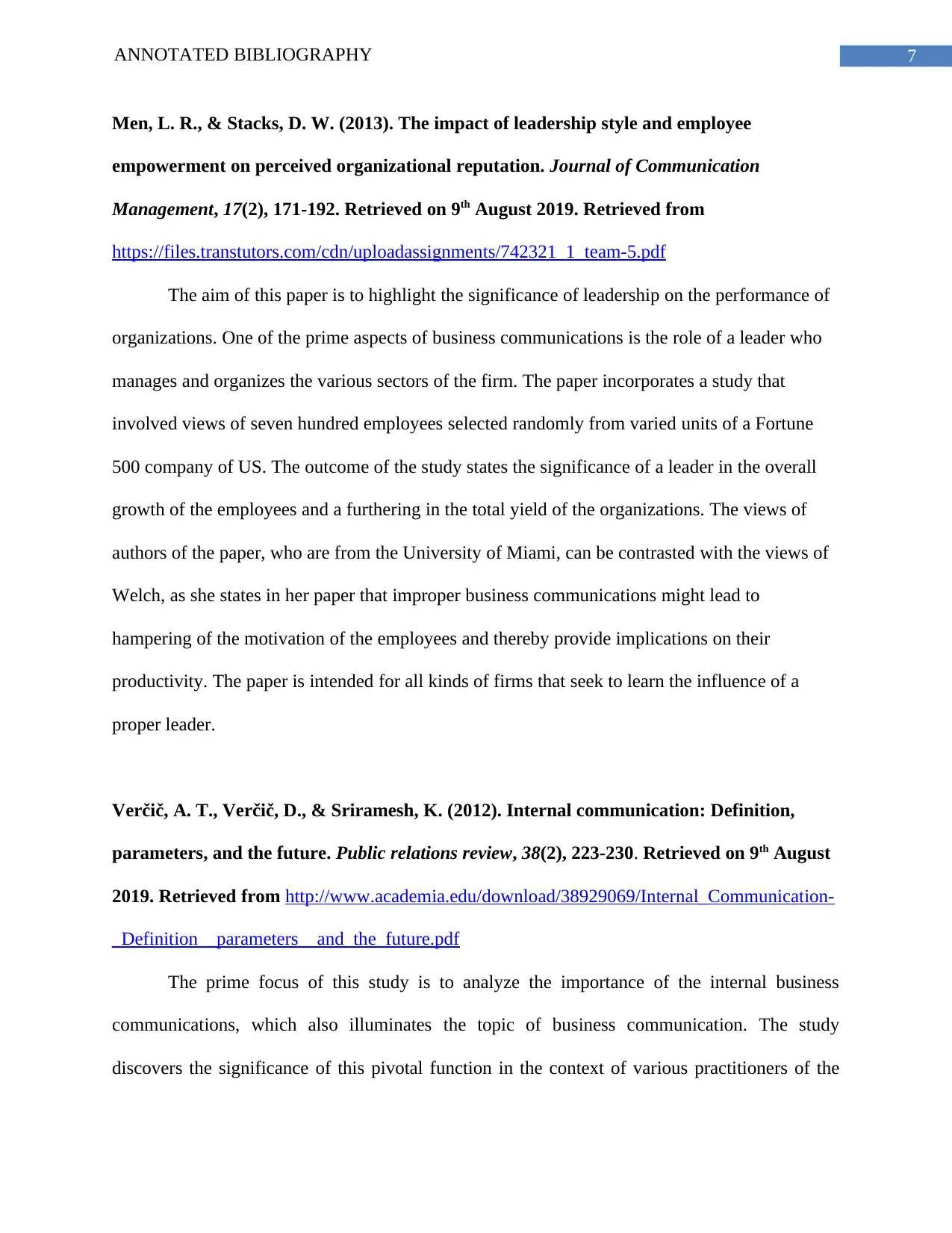
7ANNOTATED BIBLIOGRAPHY
Men, L. R., & Stacks, D. W. (2013). The impact of leadership style and employee
empowerment on perceived organizational reputation. Journal of Communication
Management, 17(2), 171-192. Retrieved on 9th August 2019. Retrieved from
https://files.transtutors.com/cdn/uploadassignments/742321_1_team-5.pdf
The aim of this paper is to highlight the significance of leadership on the performance of
organizations. One of the prime aspects of business communications is the role of a leader who
manages and organizes the various sectors of the firm. The paper incorporates a study that
involved views of seven hundred employees selected randomly from varied units of a Fortune
500 company of US. The outcome of the study states the significance of a leader in the overall
growth of the employees and a furthering in the total yield of the organizations. The views of
authors of the paper, who are from the University of Miami, can be contrasted with the views of
Welch, as she states in her paper that improper business communications might lead to
hampering of the motivation of the employees and thereby provide implications on their
productivity. The paper is intended for all kinds of firms that seek to learn the influence of a
proper leader.
Verčič, A. T., Verčič, D., & Sriramesh, K. (2012). Internal communication: Definition,
parameters, and the future. Public relations review, 38(2), 223-230. Retrieved on 9th August
2019. Retrieved from http://www.academia.edu/download/38929069/Internal_Communication-
_Definition__parameters__and_the_future.pdf
The prime focus of this study is to analyze the importance of the internal business
communications, which also illuminates the topic of business communication. The study
discovers the significance of this pivotal function in the context of various practitioners of the
Men, L. R., & Stacks, D. W. (2013). The impact of leadership style and employee
empowerment on perceived organizational reputation. Journal of Communication
Management, 17(2), 171-192. Retrieved on 9th August 2019. Retrieved from
https://files.transtutors.com/cdn/uploadassignments/742321_1_team-5.pdf
The aim of this paper is to highlight the significance of leadership on the performance of
organizations. One of the prime aspects of business communications is the role of a leader who
manages and organizes the various sectors of the firm. The paper incorporates a study that
involved views of seven hundred employees selected randomly from varied units of a Fortune
500 company of US. The outcome of the study states the significance of a leader in the overall
growth of the employees and a furthering in the total yield of the organizations. The views of
authors of the paper, who are from the University of Miami, can be contrasted with the views of
Welch, as she states in her paper that improper business communications might lead to
hampering of the motivation of the employees and thereby provide implications on their
productivity. The paper is intended for all kinds of firms that seek to learn the influence of a
proper leader.
Verčič, A. T., Verčič, D., & Sriramesh, K. (2012). Internal communication: Definition,
parameters, and the future. Public relations review, 38(2), 223-230. Retrieved on 9th August
2019. Retrieved from http://www.academia.edu/download/38929069/Internal_Communication-
_Definition__parameters__and_the_future.pdf
The prime focus of this study is to analyze the importance of the internal business
communications, which also illuminates the topic of business communication. The study
discovers the significance of this pivotal function in the context of various practitioners of the
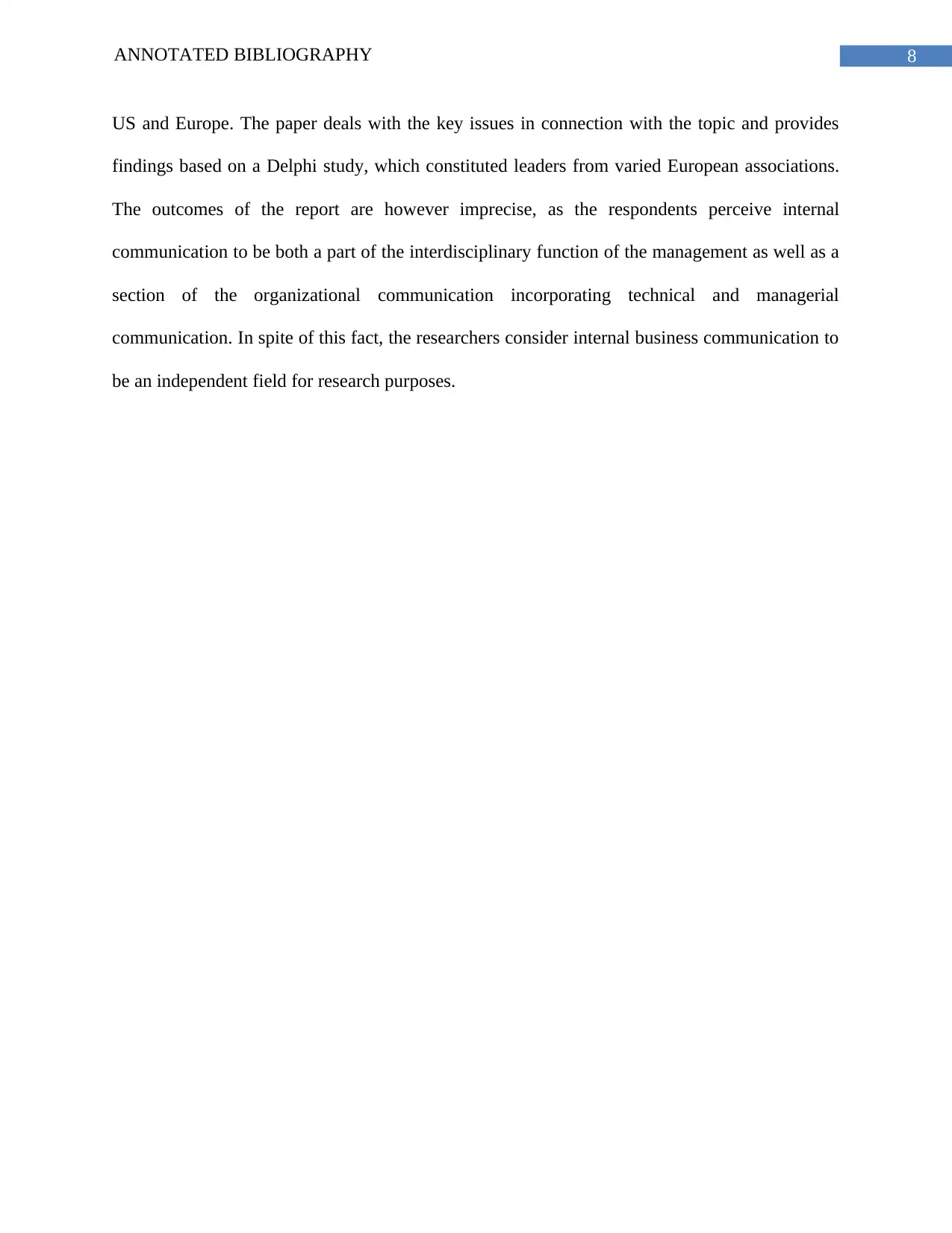
8ANNOTATED BIBLIOGRAPHY
US and Europe. The paper deals with the key issues in connection with the topic and provides
findings based on a Delphi study, which constituted leaders from varied European associations.
The outcomes of the report are however imprecise, as the respondents perceive internal
communication to be both a part of the interdisciplinary function of the management as well as a
section of the organizational communication incorporating technical and managerial
communication. In spite of this fact, the researchers consider internal business communication to
be an independent field for research purposes.
US and Europe. The paper deals with the key issues in connection with the topic and provides
findings based on a Delphi study, which constituted leaders from varied European associations.
The outcomes of the report are however imprecise, as the respondents perceive internal
communication to be both a part of the interdisciplinary function of the management as well as a
section of the organizational communication incorporating technical and managerial
communication. In spite of this fact, the researchers consider internal business communication to
be an independent field for research purposes.
⊘ This is a preview!⊘
Do you want full access?
Subscribe today to unlock all pages.

Trusted by 1+ million students worldwide
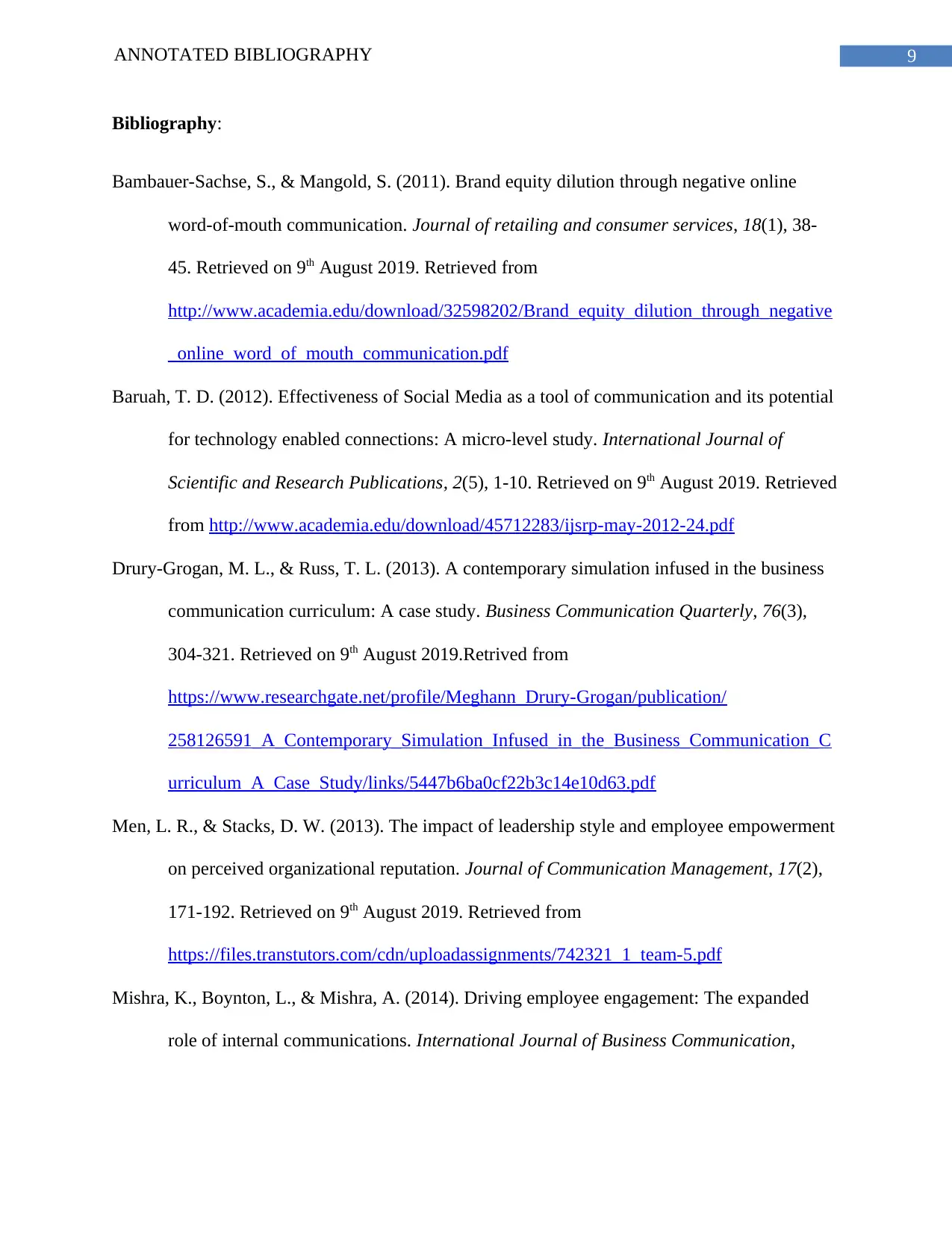
9ANNOTATED BIBLIOGRAPHY
Bibliography:
Bambauer-Sachse, S., & Mangold, S. (2011). Brand equity dilution through negative online
word-of-mouth communication. Journal of retailing and consumer services, 18(1), 38-
45. Retrieved on 9th August 2019. Retrieved from
http://www.academia.edu/download/32598202/Brand_equity_dilution_through_negative
_online_word_of_mouth_communication.pdf
Baruah, T. D. (2012). Effectiveness of Social Media as a tool of communication and its potential
for technology enabled connections: A micro-level study. International Journal of
Scientific and Research Publications, 2(5), 1-10. Retrieved on 9th August 2019. Retrieved
from http://www.academia.edu/download/45712283/ijsrp-may-2012-24.pdf
Drury-Grogan, M. L., & Russ, T. L. (2013). A contemporary simulation infused in the business
communication curriculum: A case study. Business Communication Quarterly, 76(3),
304-321. Retrieved on 9th August 2019.Retrived from
https://www.researchgate.net/profile/Meghann_Drury-Grogan/publication/
258126591_A_Contemporary_Simulation_Infused_in_the_Business_Communication_C
urriculum_A_Case_Study/links/5447b6ba0cf22b3c14e10d63.pdf
Men, L. R., & Stacks, D. W. (2013). The impact of leadership style and employee empowerment
on perceived organizational reputation. Journal of Communication Management, 17(2),
171-192. Retrieved on 9th August 2019. Retrieved from
https://files.transtutors.com/cdn/uploadassignments/742321_1_team-5.pdf
Mishra, K., Boynton, L., & Mishra, A. (2014). Driving employee engagement: The expanded
role of internal communications. International Journal of Business Communication,
Bibliography:
Bambauer-Sachse, S., & Mangold, S. (2011). Brand equity dilution through negative online
word-of-mouth communication. Journal of retailing and consumer services, 18(1), 38-
45. Retrieved on 9th August 2019. Retrieved from
http://www.academia.edu/download/32598202/Brand_equity_dilution_through_negative
_online_word_of_mouth_communication.pdf
Baruah, T. D. (2012). Effectiveness of Social Media as a tool of communication and its potential
for technology enabled connections: A micro-level study. International Journal of
Scientific and Research Publications, 2(5), 1-10. Retrieved on 9th August 2019. Retrieved
from http://www.academia.edu/download/45712283/ijsrp-may-2012-24.pdf
Drury-Grogan, M. L., & Russ, T. L. (2013). A contemporary simulation infused in the business
communication curriculum: A case study. Business Communication Quarterly, 76(3),
304-321. Retrieved on 9th August 2019.Retrived from
https://www.researchgate.net/profile/Meghann_Drury-Grogan/publication/
258126591_A_Contemporary_Simulation_Infused_in_the_Business_Communication_C
urriculum_A_Case_Study/links/5447b6ba0cf22b3c14e10d63.pdf
Men, L. R., & Stacks, D. W. (2013). The impact of leadership style and employee empowerment
on perceived organizational reputation. Journal of Communication Management, 17(2),
171-192. Retrieved on 9th August 2019. Retrieved from
https://files.transtutors.com/cdn/uploadassignments/742321_1_team-5.pdf
Mishra, K., Boynton, L., & Mishra, A. (2014). Driving employee engagement: The expanded
role of internal communications. International Journal of Business Communication,
Paraphrase This Document
Need a fresh take? Get an instant paraphrase of this document with our AI Paraphraser
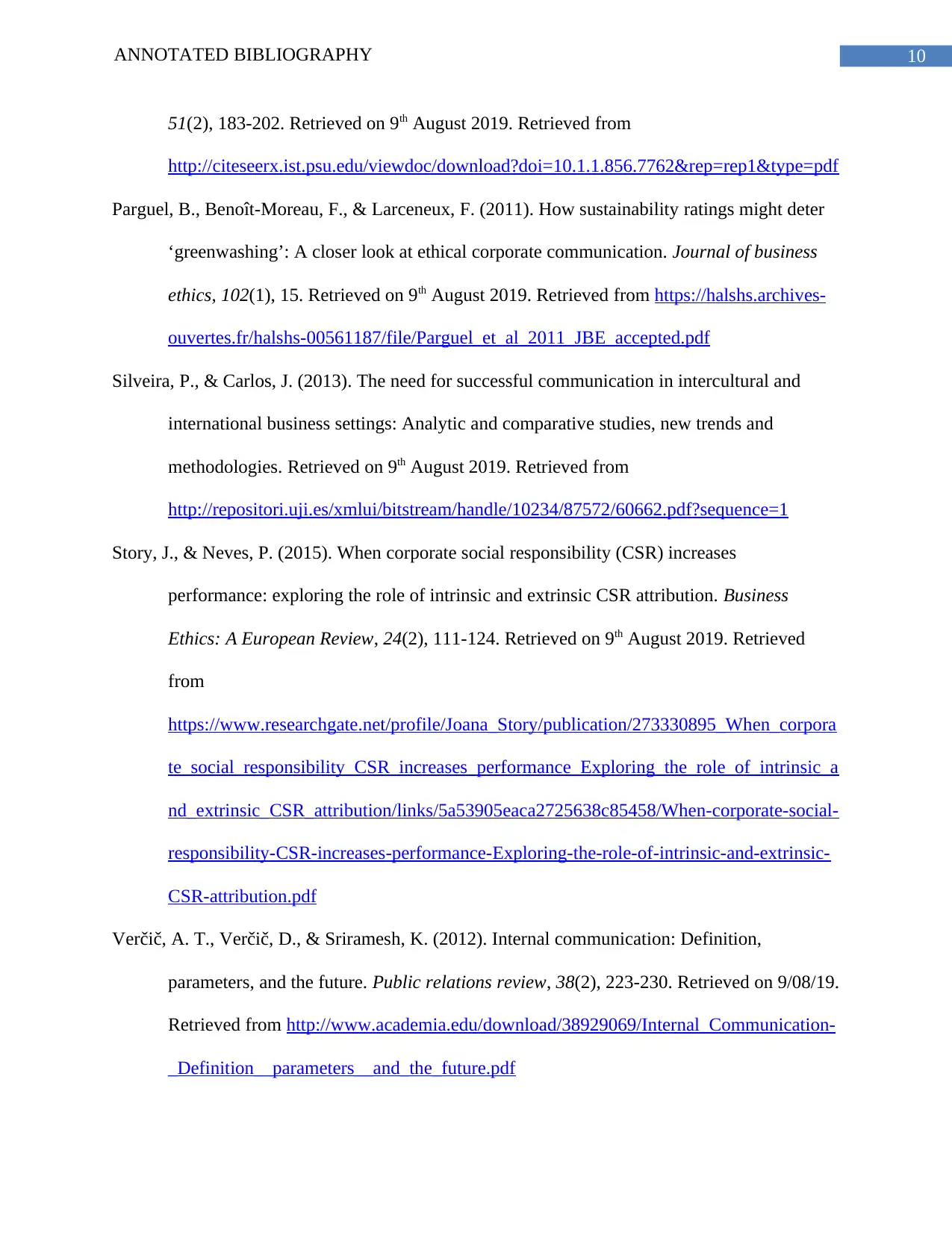
10ANNOTATED BIBLIOGRAPHY
51(2), 183-202. Retrieved on 9th August 2019. Retrieved from
http://citeseerx.ist.psu.edu/viewdoc/download?doi=10.1.1.856.7762&rep=rep1&type=pdf
Parguel, B., Benoît-Moreau, F., & Larceneux, F. (2011). How sustainability ratings might deter
‘greenwashing’: A closer look at ethical corporate communication. Journal of business
ethics, 102(1), 15. Retrieved on 9th August 2019. Retrieved from https://halshs.archives-
ouvertes.fr/halshs-00561187/file/Parguel_et_al_2011_JBE_accepted.pdf
Silveira, P., & Carlos, J. (2013). The need for successful communication in intercultural and
international business settings: Analytic and comparative studies, new trends and
methodologies. Retrieved on 9th August 2019. Retrieved from
http://repositori.uji.es/xmlui/bitstream/handle/10234/87572/60662.pdf?sequence=1
Story, J., & Neves, P. (2015). When corporate social responsibility (CSR) increases
performance: exploring the role of intrinsic and extrinsic CSR attribution. Business
Ethics: A European Review, 24(2), 111-124. Retrieved on 9th August 2019. Retrieved
from
https://www.researchgate.net/profile/Joana_Story/publication/273330895_When_corpora
te_social_responsibility_CSR_increases_performance_Exploring_the_role_of_intrinsic_a
nd_extrinsic_CSR_attribution/links/5a53905eaca2725638c85458/When-corporate-social-
responsibility-CSR-increases-performance-Exploring-the-role-of-intrinsic-and-extrinsic-
CSR-attribution.pdf
Verčič, A. T., Verčič, D., & Sriramesh, K. (2012). Internal communication: Definition,
parameters, and the future. Public relations review, 38(2), 223-230. Retrieved on 9/08/19.
Retrieved from http://www.academia.edu/download/38929069/Internal_Communication-
_Definition__parameters__and_the_future.pdf
51(2), 183-202. Retrieved on 9th August 2019. Retrieved from
http://citeseerx.ist.psu.edu/viewdoc/download?doi=10.1.1.856.7762&rep=rep1&type=pdf
Parguel, B., Benoît-Moreau, F., & Larceneux, F. (2011). How sustainability ratings might deter
‘greenwashing’: A closer look at ethical corporate communication. Journal of business
ethics, 102(1), 15. Retrieved on 9th August 2019. Retrieved from https://halshs.archives-
ouvertes.fr/halshs-00561187/file/Parguel_et_al_2011_JBE_accepted.pdf
Silveira, P., & Carlos, J. (2013). The need for successful communication in intercultural and
international business settings: Analytic and comparative studies, new trends and
methodologies. Retrieved on 9th August 2019. Retrieved from
http://repositori.uji.es/xmlui/bitstream/handle/10234/87572/60662.pdf?sequence=1
Story, J., & Neves, P. (2015). When corporate social responsibility (CSR) increases
performance: exploring the role of intrinsic and extrinsic CSR attribution. Business
Ethics: A European Review, 24(2), 111-124. Retrieved on 9th August 2019. Retrieved
from
https://www.researchgate.net/profile/Joana_Story/publication/273330895_When_corpora
te_social_responsibility_CSR_increases_performance_Exploring_the_role_of_intrinsic_a
nd_extrinsic_CSR_attribution/links/5a53905eaca2725638c85458/When-corporate-social-
responsibility-CSR-increases-performance-Exploring-the-role-of-intrinsic-and-extrinsic-
CSR-attribution.pdf
Verčič, A. T., Verčič, D., & Sriramesh, K. (2012). Internal communication: Definition,
parameters, and the future. Public relations review, 38(2), 223-230. Retrieved on 9/08/19.
Retrieved from http://www.academia.edu/download/38929069/Internal_Communication-
_Definition__parameters__and_the_future.pdf
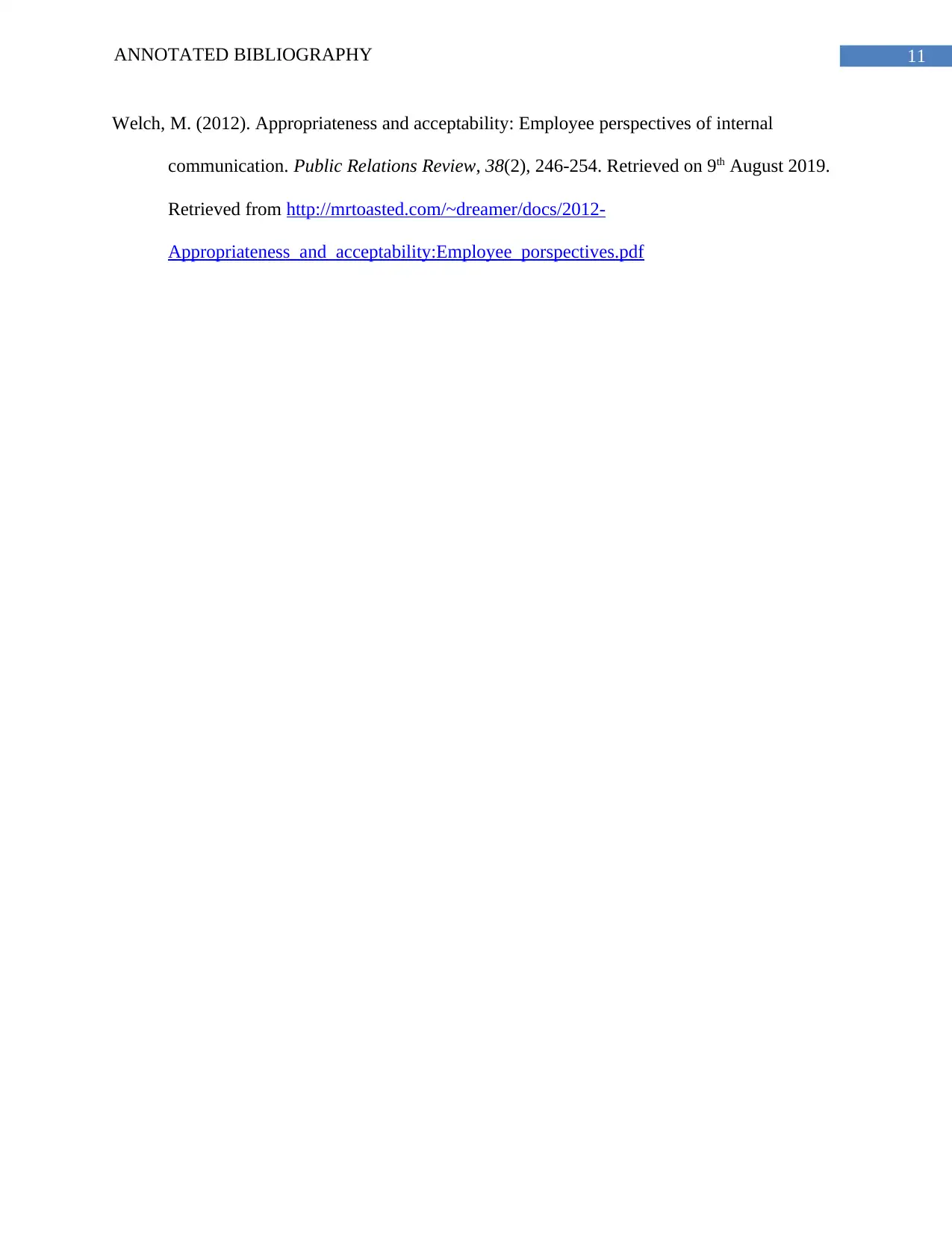
11ANNOTATED BIBLIOGRAPHY
Welch, M. (2012). Appropriateness and acceptability: Employee perspectives of internal
communication. Public Relations Review, 38(2), 246-254. Retrieved on 9th August 2019.
Retrieved from http://mrtoasted.com/~dreamer/docs/2012-
Appropriateness_and_acceptability:Employee_porspectives.pdf
Welch, M. (2012). Appropriateness and acceptability: Employee perspectives of internal
communication. Public Relations Review, 38(2), 246-254. Retrieved on 9th August 2019.
Retrieved from http://mrtoasted.com/~dreamer/docs/2012-
Appropriateness_and_acceptability:Employee_porspectives.pdf
⊘ This is a preview!⊘
Do you want full access?
Subscribe today to unlock all pages.

Trusted by 1+ million students worldwide
1 out of 12
Your All-in-One AI-Powered Toolkit for Academic Success.
+13062052269
info@desklib.com
Available 24*7 on WhatsApp / Email
![[object Object]](/_next/static/media/star-bottom.7253800d.svg)
Unlock your academic potential
Copyright © 2020–2025 A2Z Services. All Rights Reserved. Developed and managed by ZUCOL.


